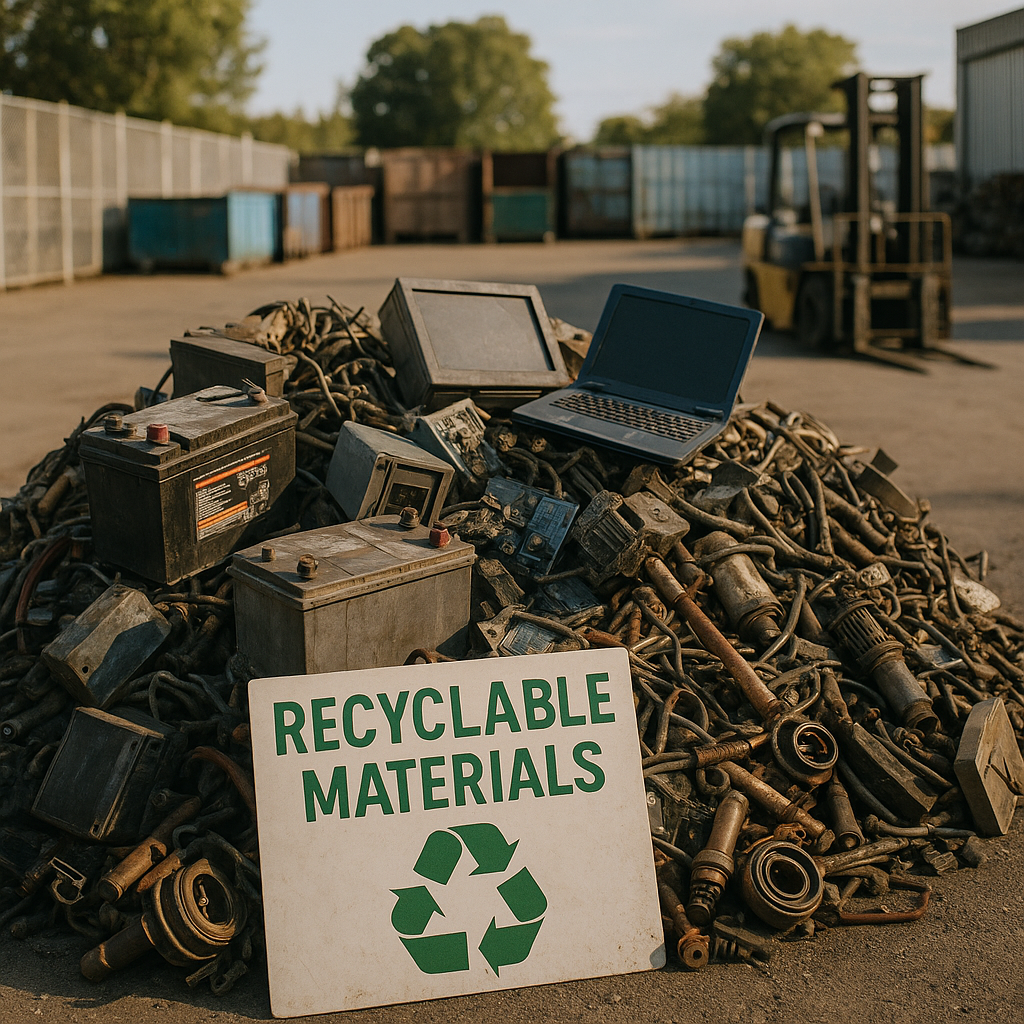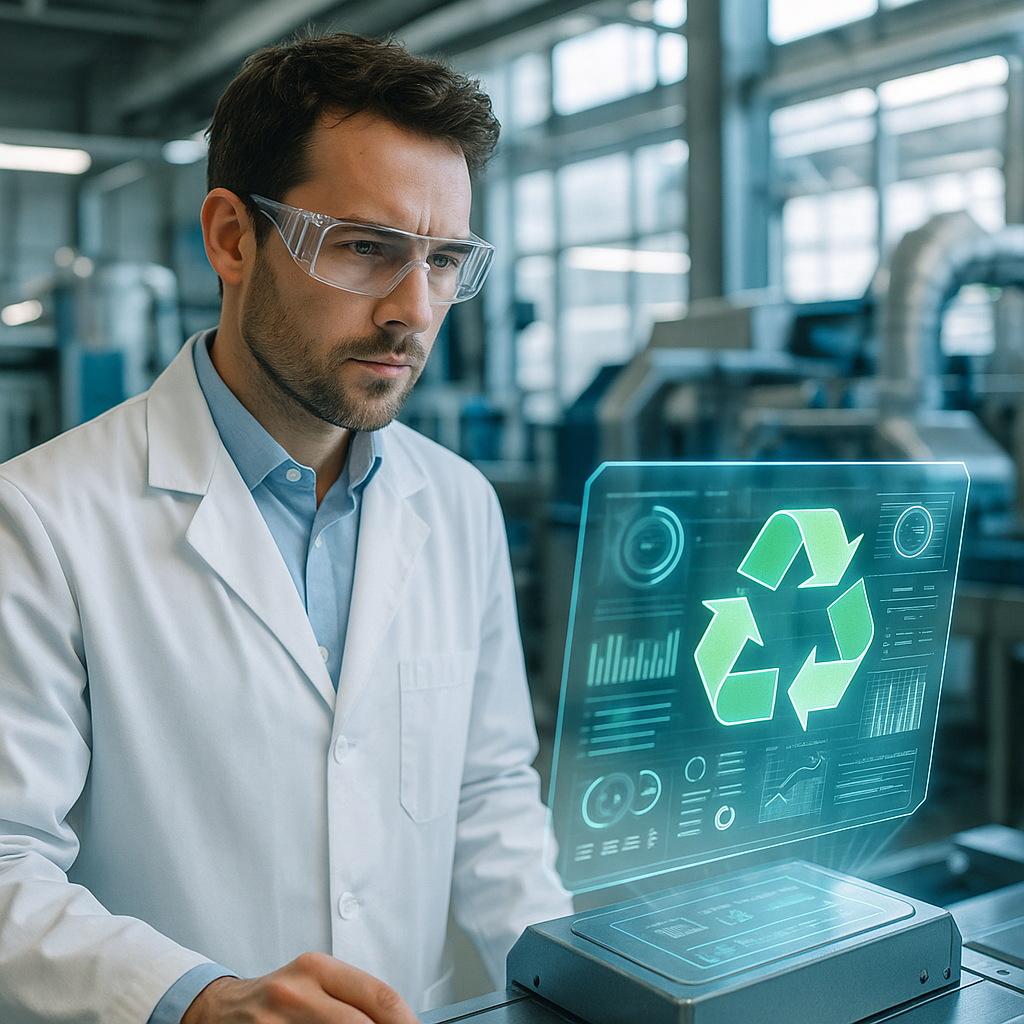5901 Botham Jean Blvd, Dallas, TX 75215
Antimony Recycling Process: A Guide to Methods, Sources & Benefits
October 28, 2025Antimony recycling is the sustainable recovery of antimony from end-of-life products and industrial residues. This process is particularly crucial for lead-acid batteries, which are among the largest sources of secondary antimony in the circular economy.
The recycling process involves several key steps, starting with battery collection and preparation. Spent batteries undergo a systematic breakdown that includes acid drainage, crushing, and component separation. The batteries are mechanically split into their constituent parts: plastic cases, metallic grids, separators, and lead paste containing antimony compounds.
Once separated, the battery components go through further processing. The lead-antimony grids are typically smelted in furnaces, where antimony is oxidized and volatilized as antimony trioxide. This compound is then recovered and reduced to produce metallic antimony with purities nearing 99.9%. The process recovers valuable antimony that would otherwise end up in landfills and reduces the environmental impact of battery disposal.
What are the Key Steps in Antimony Recycling?

Antimony recycling is a specialized metallurgical process that recovers this critical raw material from various waste streams, primarily lead-acid batteries. The process follows a carefully designed sequence to extract antimony efficiently while managing environmental impacts. Here are the key steps involved in this essential recycling operation.
Battery Wrecking and Acid Removal
The recycling process begins with battery wrecking, where used batteries are fed into a dual wheel puncher, which perforates the battery cells to release sulfuric acid. This acid is collected, filtered, neutralized, and sent to water treatment facilities to prevent environmental contamination.
After acid removal, batteries move through a cooling chamber that uses liquid nitrogen to chill them. This cooling step prepares the batteries for the next phase by making the components more brittle and easier to separate.
Crushing and Separation
The chilled batteries are fed into an enclosed single-roll crusher. The crusher contains teeth that shred the batteries against breaker bars, reducing them to smaller fragments. This crushing step is crucial for exposing the internal components.
Next, the shredded battery scrap enters a heavy-media separator. Here, the paste portion forms a slurry of about 1.4 grams per cubic centimeter density. The plastic, hard rubber, and separators float and are removed by screws to the polypropylene recovery system. The lead-bearing components, including antimony, sink and are removed via a drag conveyor.
Desulfurization Process
The paste slurry is collected in a sump and pumped into desulfurization tanks. Sodium carbonate is added under controlled pH conditions to convert the lead sulfate into more processable compounds. This reaction takes place at room temperature and completes within an hour.
The desulfurized paste is then filtered in a plate and frame filter press. The sodium sulfate solution is pumped to water treatment, while the filter cake is washed to remove remaining sodium sulfate. This process reduces the sulfur content of the paste from about 6% to less than 0.5%.
Smelting in Reverberatory Furnace
The desulfurized materials are blended with grids, reducing agents, and fluxes before being charged to the reverberatory furnace. This furnace, typically 2.4 meters wide by 10 meters long, is fired by natural gas burners. The mixed dried charge is fed continuously to the furnace by means of a closed steel pan conveyor.
In the furnace, a key metallurgical transformation occurs. Aluminum, antimony, arsenic, calcium, tin, and other alloying elements in the battery components are oxidized and enter the slag phase. Meanwhile, the lead is reduced and recovered as low-impurity bullion. The furnace operates under controlled conditions with both oxidizing and reducing atmospheres produced simultaneously.
Electric Furnace Processing
The slag containing antimony overflows the furnace continuously and solidifies on a slag caster. This slag typically contains 4-8% antimony oxide along with other metal oxides. This antimony-rich slag is then processed in an electric furnace.
In the electric furnace, the slag is mixed with fluxes and reducing agents. The furnace operates at high temperatures where antimony, arsenic, and tin are reduced from the slag to their elemental forms. When the furnace is fully charged (about 30 tons of slag), the material is held at temperature to reduce the metal to the desired level.
The resulting metal bullion typically contains 13-18% antimony, along with smaller amounts of tin, arsenic, copper, and nickel. The balance is primarily lead. This antimony-rich bullion can then be used to produce various lead-antimony alloys with 0.75 to 10% antimony content for industrial applications.
This comprehensive process efficiently recovers antimony from waste batteries, reducing the need for primary mining of this critical raw material while preventing harmful environmental contamination.
What are the Main Sources of Recyclable Antimony?

Lead-acid batteries are the predominant source of recycled antimony, accounting for about 95% of the antimony recovered globally. The antimonial lead alloys in these batteries—particularly in the grid plates, straps, and terminals—form a crucial supply for antimony recycling, which is essential for global supply chains. This significant percentage highlights the vital role of the automotive and industrial battery sectors in antimony recycling efforts.
In addition to batteries, other smaller sources contribute to the antimony recycling stream:
- Electronic waste: Antimony is present in flame-retardant plastics used in electronic equipment. As e-waste recycling advancements continue, this source’s value may increase. Modern electronics contain antimony in circuit boards and various components, recoverable through specialized metallurgical processes.
- Metal alloys: Antimony enhances hardness and durability in various alloys. Items like bearings, cable sheaths, and pewter products contain recoverable antimony and enter the recycling stream upon reaching end-of-life.
- Flame retardants: While recovering antimony trioxide from flame retardants has been challenging, new technologies are emerging to extract it from treated materials. Polymers with antimony flame retardants, particularly in polyethylene terephthalate (PET), can retain antimony within the recycling loop.
Recycling antimony from these sources provides significant benefits. It reduces reliance on mining operations, mainly concentrated in China, which supplies about 80% of the world’s primary antimony. This diversification enhances supply security for countries that regard antimony as critical. Additionally, recycling conserves natural resources by prolonging the lifespan of extracted antimony and mitigating the environmental impact of primary mining activities.
The recycling process differs based on the source material. For lead-acid batteries, facilities typically crush the batteries, separate the components, and process the antimonial lead through smelting. The antimony is recovered during the refining of lead. For electronic waste, more complex metallurgical processes are necessary to separate the various metals and metalloids, including antimony.
As regulations around critical materials tighten and resource security becomes increasingly important, the antimony recycling sector is poised for continued innovation and growth, potentially expanding beyond lead-acid batteries as the primary source material.
What are the Environmental Benefits of Antimony Recycling?
Recycling antimony offers significant environmental benefits by reducing reliance on primary mining operations. By recycling antimony from sources such as lead-acid batteries, we conserve natural reserves of this rare metalloid. Since antimony is relatively scarce in the Earth’s crust—present at only about 0.2 parts per million—every ton recycled helps extend the life of existing deposits.
The benefits of conservation extend beyond the metal itself. Primary antimony mining can be environmentally disruptive, requiring extensive land clearing, excavation, and waste disposal. These activities fragment habitats, disturb wildlife, and can lead to soil erosion. Recycling antimony reduces the environmental footprint of mining operations and helps preserve natural ecosystems.
Energy conservation is another significant benefit of antimony recycling. Processing recycled antimony typically requires 60-70% less energy than extracting and refining it from virgin ore. This energy saving directly translates to reduced carbon emissions and a lower overall climate impact. For example, recovering antimony from lead-acid batteries consumes substantially less energy than the processes needed to mine, crush, separate, and refine antimony from primary sources.
Water conservation is often an overlooked advantage of antimony recycling. Primary mining operations frequently use large amounts of water for ore processing and dust suppression. By recycling existing antimony, we decrease the demand for this precious resource, which is especially important in water-stressed regions where mining competes with agricultural and municipal water needs.
Proper antimony recycling also prevents pollution. Antimony compounds can be toxic if released into the environment, potentially contaminating soil and water systems. When antimony-containing products are improperly disposed of in landfills, these compounds may leach into groundwater over time. Recycling captures this potentially harmful material and reintegrates it into the production cycle, preventing environmental contamination.
Waste reduction is another environmental benefit of antimony recycling. The primary mining and refining of antimony generate significant amounts of waste rock and tailings, which must be managed to prevent environmental harm. Recycling antimony-containing products minimizes this waste stream, reducing the need for tailings ponds and waste rock storage facilities that can pose long-term environmental risks.
The environmental advantages of antimony recycling are particularly important given the geopolitical aspects of antimony supply. With over 70% of global antimony production concentrated in China, recycling provides a domestic source that reduces dependence on imports while delivering environmental benefits. This recycling-focused approach aligns perfectly with circular economy principles, where materials are used for as long as possible before being recovered and regenerated at the end of their service life.
Conclusion: The Future of Antimony Recycling

Antimony recycling is a cornerstone of sustainable resource management in the evolving materials landscape. With global demand for antimony rising across applications in flame retardants, batteries, and defense, establishing robust recycling infrastructure has become essential. The current recycling rate of about 25% shows progress, but also highlights the potential for improvement in our approach to this valuable element.
Looking ahead, several technological advancements offer promise for enhancing the efficiency of antimony recycling. Innovations in metallurgical recovery processes aim to extract antimony from a broader range of post-consumer products, while automation and advanced sorting technologies work to reduce processing costs. These developments will be crucial as market projections indicate that antimony demand could reach $3.17 billion by 2035, driven by expanding applications in energy storage and green technologies.
For businesses and municipalities wanting to contribute to antimony’s circular economy, now is the time to evaluate waste streams and implement proper recycling protocols. By doing so, you will not only support supply chain resilience but also reduce the environmental impacts associated with primary mining. To learn how your organization can engage in metal recycling initiatives or implement effective recycling programs, contact Okon Recycling at 214-717-4083.
